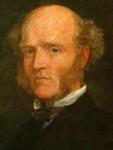Authors > Thomas Hughes

Thomas Hughes
Sex: Male
Country: EnglandBirth & Death: 1822-1896
Thomas Hughes (20 October 1822 – 22 March 1896) was an English lawyer and author. He is most famous for his novel Tom Brown's School Days (1857), a semi-autobiographical work set at Rugby School, which Hughes had attended. It had a lesser-known sequel, Tom Brown at Oxford (1861).
Hughes was the second son of John Hughes, editor of the Boscobel Tracts (1830). Thomas Hughes was born in Uffington, Berkshire (now Oxfordshire). He had six brothers, and one sister, Jane Senior who later became Britain's first female civil servant. At the age of eight he was sent to Twyford School, a preparatory public school near Winchester, where he remained until the age of eleven. In February 1834 he went to Rugby School, which was then under Dr Thomas Arnold, a contemporary of his father at Oriel College, Oxford, and the most influential British schoolmaster of the 19th century. Though never a member of the sixth form, his impressions of the headmaster were intensely reverent, and Arnold was afterwards idealised as the perfect schoolmaster in Hughes's novel. Hughes excelled at sports rather than in scholarship, and his school career culminated in a cricket match at Lord's Cricket Ground. In 1842 he went on to Oriel College, Oxford, and graduated B.A. in 1845. He was called to the bar in 1848, became Queen's Counsel in 1869 and a bencher in 1870, and was appointed to a county court judgeship in the Chester district in July 1882.
Hughes was elected to Parliament as a Liberal for Lambeth (1865–68), and for Frome (1868–74). An avid social reformer, he became interested in the Christian socialism movement led by Frederick Maurice, which he had joined in 1848. He was involved in the formation of some early trade unions and helped finance the printing of Liberal publications, as well as acting as the first President of the Co-operative Congress in 1869 and serving on the Co-operative Central Board. In January 1854 he was one of the founders of the Working Men's College in Great Ormond Street, and was the College's principal from 1872 to 1883. He was a prominent figure in the anti-opium movement, and a member of the Society for the Suppression of the Opium Trade.
In 1880, he acquired the ownership of Franklin W. Smith's Plateau City and founded a settlement in America — Rugby, Tennessee — which was designed as an experiment in utopian living for the younger sons of the English gentry, although this later proved largely unsuccessful. While his original intent was unsuccessful, Rugby still exists and is listed on the U.S. National Register of Historic Places.
In 1847, Hughes was called to the bar, and married Frances Ford. They settled in 1853 at Wimbledon and while living there Hughes wrote his famous story Tom Brown's School Days, which was published in April 1857.
Hughes also wrote The Scouring of the White Horse (1859), Tom Brown at Oxford (1861), Religio Laici (1868), Life of Alfred the Great (1869) and the Memoir of a Brother. His brother was George Hughes, whom the character of Tom Brown was based upon.
Hughes died in 1896 aged 73, at Brighton, of heart failure; and is buried there. His daughter, Lilian, perished in the sinking of the RMS Titanic in 1912. His other daughter, Mary, was a well known Poor Law guardian and volunteer visitor to the local Poor Law infirmary and children's home.
A statue of Hughes (pictured) stands outside Rugby School Library. It has been observed that although the sculptor has meticulously crafted a row of buttons on the right hand side of the statue's jacket, there are no corresponding buttonholes on the left hand side. Local folklore has it that when this omission was pointed out to the sculptor, a known perfectionist who suffered from depression, he was so dismayed that he was driven to commit suicide. This is untrue. The sculptor was Thomas Brock, the statue was unveiled in 1899, and Brock died of natural causes in 1922.
Comment:
- Information Loading...
Your Comment: